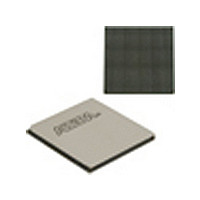EP4SGX530HH35C2N Altera, EP4SGX530HH35C2N Datasheet - Page 568

EP4SGX530HH35C2N
Manufacturer Part Number
EP4SGX530HH35C2N
Description
IC STRATIX IV FPGA 530K 1152HBGA
Manufacturer
Altera
Series
Stratix® IV GXr
Datasheets
1.EP4SGX110DF29C3N.pdf
(80 pages)
2.EP4SGX110DF29C3N.pdf
(1154 pages)
3.EP4SGX110DF29C3N.pdf
(432 pages)
4.EP4SGX110DF29C3N.pdf
(22 pages)
5.EP4SGX110DF29C3N.pdf
(30 pages)
6.EP4SGX110DF29C3N.pdf
(72 pages)
7.EP4SGX530HH35C2N.pdf
(1145 pages)
Specifications of EP4SGX530HH35C2N
Number Of Logic Elements/cells
531200
Number Of Labs/clbs
21248
Total Ram Bits
27376
Number Of I /o
564
Voltage - Supply
0.87 V ~ 0.93 V
Mounting Type
Surface Mount
Operating Temperature
0°C ~ 85°C
Package / Case
1152-HBGA
Family Name
Stratix® IV
Number Of Logic Blocks/elements
531200
# Registers
424960
# I/os (max)
560
Process Technology
40nm
Operating Supply Voltage (typ)
900mV
Logic Cells
531200
Ram Bits
28033024
Operating Supply Voltage (min)
0.87V
Operating Supply Voltage (max)
0.93V
Operating Temp Range
0C to 85C
Operating Temperature Classification
Commercial
Mounting
Surface Mount
Pin Count
1152
Package Type
FCHBGA
Lead Free Status / RoHS Status
Lead free / RoHS Compliant
Number Of Gates
-
Lead Free Status / Rohs Status
Compliant
Available stocks
Company
Part Number
Manufacturer
Quantity
Price
- EP4SGX110DF29C3N PDF datasheet
- EP4SGX110DF29C3N PDF datasheet #2
- EP4SGX110DF29C3N PDF datasheet #3
- EP4SGX110DF29C3N PDF datasheet #4
- EP4SGX110DF29C3N PDF datasheet #5
- EP4SGX110DF29C3N PDF datasheet #6
- EP4SGX530HH35C2N PDF datasheet #7
- Current page: 568 of 1154
- Download datasheet (32Mb)
1–124
Figure 1–103. CPRI Topologies
Stratix IV Device Handbook Volume 2: Transceivers
1
In order to achieve deterministic latency through the transceiver, the reference clock
to the CMU PLL must be the same as the low-speed parallel clock. For example, if you
need a data rate of 1.2288 Gbps to be implemented for the CPRI protocol that places
stringent requirements on the amount of latency variation, you must choose a
reference clock of 122.88 MHz to allow for a feedback path from the CMU PLL to be
used. This feedback path reduces the variations in latency.
When selecting this option, you must provide an input reference clock to the CMU
PLL that is of the same frequency as the low-speed parallel clock.
In a CPRI implementation, the input reference clock to the CMU PLL must be the
same as the low-speed parallel clock. Each CPRI channel uses one CMU PLL;
therefore, each transceiver block can implement two CPRI ×1 channels only.
ATX PLLs do not have the feedback path enabled; therefore, they cannot be used for
implementing the CPRI configuration.
In the deterministic latency ×4 option, up to four CPRI TX channels can be bundled in
an ×4 group so that they all have the same TX uncertainty and just require one TX PLL
to compensate for it. This is allowed in cases where the data rates are multiples of a
single PLL output frequency; for example, 0.6144 Gbps, 1.228 Gbps, 2.4576 Gbps, and
4.9152 Gbps. For ×4 bundled channels to maintain PLL lock during auto-negotiation,
the IP must use over-sampling (sending the same bit multiple times) to output lower
auto-negotiated line rates. Do not use the hard 8B/10B for oversampled channels.
CPRI and OBSAI
You can use deterministic latency functional mode to implement protocols such as
CPRI and OBSAI.
The CPRI interface defines a digital point-to-point interface between the Radio
Equipment Control (REC) and the Radio Equipment (RE) allowing flexibility in either
co-locating the REC and the RE or remote location of the RE.
various CPRI topologies. In most cases, CPRI links are between REC and RE modules
or between two RE modules in a chain configuration.
RE
RE
RE
RE
Ring
Chain
RE
RE
Radio Equipment
Control
REC
Piont-to-Point
Chapter 1: Transceiver Architecture in Stratix IV Devices
RE
RE
Tree and Branch
RE
RE
February 2011 Altera Corporation
Figure 1–103
Transceiver Block Architecture
shows
Related parts for EP4SGX530HH35C2N
Image
Part Number
Description
Manufacturer
Datasheet
Request
R

Part Number:
Description:
CYCLONE II STARTER KIT EP2C20N
Manufacturer:
Altera
Datasheet:

Part Number:
Description:
CPLD, EP610 Family, ECMOS Process, 300 Gates, 16 Macro Cells, 16 Reg., 16 User I/Os, 5V Supply, 35 Speed Grade, 24DIP
Manufacturer:
Altera Corporation
Datasheet:

Part Number:
Description:
CPLD, EP610 Family, ECMOS Process, 300 Gates, 16 Macro Cells, 16 Reg., 16 User I/Os, 5V Supply, 15 Speed Grade, 24DIP
Manufacturer:
Altera Corporation
Datasheet:

Part Number:
Description:
Manufacturer:
Altera Corporation
Datasheet:

Part Number:
Description:
CPLD, EP610 Family, ECMOS Process, 300 Gates, 16 Macro Cells, 16 Reg., 16 User I/Os, 5V Supply, 30 Speed Grade, 24DIP
Manufacturer:
Altera Corporation
Datasheet:

Part Number:
Description:
High-performance, low-power erasable programmable logic devices with 8 macrocells, 10ns
Manufacturer:
Altera Corporation
Datasheet:

Part Number:
Description:
High-performance, low-power erasable programmable logic devices with 8 macrocells, 7ns
Manufacturer:
Altera Corporation
Datasheet:

Part Number:
Description:
Classic EPLD
Manufacturer:
Altera Corporation
Datasheet:

Part Number:
Description:
High-performance, low-power erasable programmable logic devices with 8 macrocells, 10ns
Manufacturer:
Altera Corporation
Datasheet:

Part Number:
Description:
Manufacturer:
Altera Corporation
Datasheet:

Part Number:
Description:
Manufacturer:
Altera Corporation
Datasheet:

Part Number:
Description:
Manufacturer:
Altera Corporation
Datasheet:

Part Number:
Description:
CPLD, EP610 Family, ECMOS Process, 300 Gates, 16 Macro Cells, 16 Reg., 16 User I/Os, 5V Supply, 25 Speed Grade, 24DIP
Manufacturer:
Altera Corporation
Datasheet:












